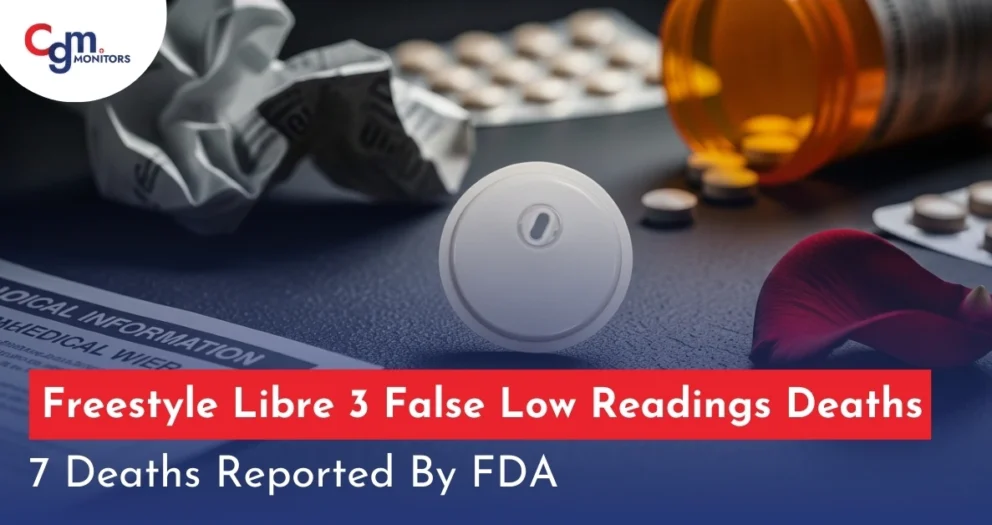Table of content
- Diabetes Types and Progression: Can Type 2 Become Type 1?
- How Confusing Diabetes Types Lead to Misdiagnosis
- Diagnostic Methods for Identifying Type 1 vs. Type 2 Diabetes
- Type 1 vs. Type 2 Diabetes: Symptoms, Causes, and Treatments
- Treatment Approaches for Type 1 Diabetes
- Treatment Approaches for Type 2 Diabetes
- Insulin Dependence and Diabetes
- Common Misdiagnosis Problems with Latent Autoimmune Diabetes in Adults
- Tools and Technologies for Managing Type 1 and Type 2 Diabetes (CGM & More)
- Final Words
- Frequently Asked Questions
More than 37 million people across the US have diabetes. About 90% have type 2 diabetes, while 5-10% have type 1. Both types of diabetes affect the insulin-related regulation of glucose, but they differ in their causes and duration of onset, and treatment. A few patients inquire can type 2 diabetes turn to Type 1 Diabetes; however, these are two distinct conditions that have no clear progression from one to the other.
But misdiagnosis and similar features, especially for adults, could confuse types 1 and 2 diabetes. The ability to control blood glucose in a controlled manner is an important requirement for both situations. Continuous glucose monitoring (CGM) systems from Abbott, Dexcom, and Medtronic today provide stable glycemic control for all types of diabetes. This article reviews the facts, clarifies T1D vs T2D, and explains diagnostic overlap.
Diabetes Types and Progression: Can Type 2 Become Type 1?
Despite occasional confusion in diagnosis, type 2 diabetes does not turn into type 1 diabetes. They are distinct diseases with different causes. An example is how Type 1 diabetes involves immune damage to insulin-making cells, while Type 2 features resistance to insulin. In rare instances, the person who is suffering from type 2 might later be diagnosed with type 1 because of tests for autoimmune disease. This is often the cause of searches such as “can type 2 diabetes turn to type 1 diabetes,” even though, from a medical perspective, it is not possible to convert.
How Confusing Diabetes Types Lead to Misdiagnosis
Diagnosing diabetes type correctly is not always straightforward, especially in adults who do not fit the expected clinical profile. A significant number of obese adults with type 1 diabetes are initially told they have type 2. This early misclassification is not a change in disease, but it’s only an incorrect diagnosis.
No glucose test alone can confirm diabetes type. While blood sugar levels are used to diagnose diabetes, they do not distinguish between autoimmune failure and insulin resistance. Accurate classification requires further testing, see below!
Diagnostic Methods for Identifying Type 1 vs. Type 2 Diabetes
- Autoantibody testing: Over 90% of people with type 1 diabetes have antibodies targeting pancreatic beta cells. Their presence strongly supports a diagnosis of type 1.
- C-peptide levels: The test shows the amount of insulin your body creates. Low levels are common in type 1, but they also appear in longstanding type 2 cases with advanced pancreatic decline.
- Clinical presentation and age: Adult cases of Type 1 diabetes do happen. Similarly, type 2 is now being identified in younger individuals, especially in those with elevated BMI. Age alone is not a reliable diagnostic marker.

Misdiagnosis data shows the scope of the problem:
- Around 40-45% of adults with type 1 diabetes are initially diagnosed with type 2.
- In youth populations, 7% of diabetes diagnoses are misclassified, probably due to rising obesity rates in children.
- Outdated terms like “juvenile-onset” and “adult-onset” are no longer used because the age-based distinction no longer applies in clinical practice.
Type 1 vs. Type 2 Diabetes: Symptoms, Causes, and Treatments
Signs and treatments to help identify Type 1 or Type 2 Diabetes!
Causes of Type 1 Diabetes
- Autoimmune destruction of insulin-producing beta cells
- Genetic risk from certain immune-related gene variants
- Environmental triggers, like viruses, in genetically at-risk individuals
- Not lifestyle-related, unrelated to diet, weight, or activity
Causes of Type 2 Diabetes
- Insulin resistance, cells don’t respond to insulin
- Beta cell dysfunction over time
- Obesity and inactivity, especially central fat
- Genetic and age-related susceptibility
- Higher risk in some ethnic groups and those with a gestational diabetes history
Treatment Approaches for Type 1 Diabetes
- Insulin therapy is mandatory from diagnosis. Because pancreatic beta cells are destroyed, the body produces no insulin.
- Delivery methods include multiple daily injections or insulin pumps, with continuous glucose monitoring (CGM) to assist dosing accuracy.
- Lifestyle Management: supports glycemic control and reduces risk for complications, but does not replace the need for insulin.
- Monitoring tools: Real-time CGM devices like the freeStyle Libre 3 sensor help detect glycemic fluctuations and improve time-in-range targets.
- Adjunctive therapy: While insulin is the cornerstone, some adults may also benefit from glucose-lowering agents under specialist supervision.

Treatment Approaches for Type 2 Diabetes
- Initial focus is placed on medical nutrition therapy, physical activity, and body weight reduction, especially in early or mild cases.
- First-line pharmacologic therapy often includes metformin, which reduces hepatic glucose production and improves insulin sensitivity. Read this to know more about metformin benefits and side effects.
- Other oral and injectable agents include SGLT2 inhibitors, GLP-1 receptor agonists, and DPP-4 inhibitors.
- Insulin might be introduced if oral therapies are no longer sufficient. For more details, check out our full guide on Does Type 2 Diabetes Need Insulin?
- Lifestyle changes remain foundational even after medication begins, including ongoing dietary adjustments and monitored exercise regimens.
Comprehensive Comparison Table: Type 1 vs. Type 2 Diabetes
| Feature | Type 1 Diabetes | Type 2 Diabetes |
| What happens in the body? | The immune system destroys insulin-producing cells | The body stops responding well to insulin; production drops over time |
| Insulin production | None or nearly none | Starts off normal, then decreases |
| Need for insulin | Always required from the start | Might be needed later, depending on progression |
| How fast does it appear? | Sudden, especially in younger people | Develops slowly—often goes unnoticed |
| Who gets it? | Often diagnosed in kids or teens, but it can happen at any age | Common in adults, now rising in teens and children, too |
| Symptoms | Quick onset: weight loss, thirst, frequent urination, fatigue | Slow onset: tiredness, blurry vision, slow healing, more urination |
| Weight at diagnosis | Usually lean or normal weight | Often above the recommended weight range |
| Family history | Linked to autoimmune conditions like thyroid or celiac disease | More often runs in families with type 2 or pregnancy-related diabetes |
| How it’s diagnosed | Blood sugar, antibody tests, and C-peptide levels | Blood sugar and C-peptide antibody tests are usually negative |
| Role of lifestyle | Helps control, but doesn’t prevent or stop the condition | Key to delaying, managing, or even improving the condition |
| Can it be reversed? | No | Some cases can improve significantly with long-term changes |
| Ongoing care | Daily insulin, CGM, meal planning, endocrinologist support | Diet, activity, medication, glucose monitoring, and regular doctor visits |
| Ketoacidosis risk | High if insulin is missed | Rare, but it can happen in later stages |
Insulin Dependence and Diabetes
Both major forms of diabetes can involve insulin dependency, but the underlying cause differs. People with type 1 diabetes lack insulin entirely due to autoimmune beta cell destruction. This makes insulin treatment non-negotiable from diagnosis onward. In contrast, type 2 diabetes is insulin-dependent only in later stages, after progressive beta cell decline.
Note!
People with insulin-dependent type 2 diabetes benefit from the same technologies as those with type 1, such as CGMs and insulin pumps from cgm monitors, to get dosing and reduce the risks of hypoglycemia.
Common Misdiagnosis Problems with Latent Autoimmune Diabetes in Adults
Latent Autoimmune Diabetes in Adults (LADA) is often misclassified as type 2 diabetes, especially in lean people over 30. Here’s all you need to know:
- LADA is sometimes called “type 1.5” diabetes due to features overlapping both type 1 and type 2 diabetes.
- Many with LADA hold some insulin production for months or years post-diagnosis.
- Diagnosis criteria include positive autoantibodies, adult onset, and delayed insulin need.
Physicians often miss LADA because of its slow onset and age of presentation. An estimated 4-12% of adults diagnosed with type 2 diabetes have LADA but are mismanaged due to a lack of antibody testing.
Tools and Technologies for Managing Type 1 and Type 2 Diabetes (CGM & More)
Both type 1 and type 2 diabetes require daily glucose management, medication, and long-term complication prevention. Continuous glucose monitors (CGMs), such as advanced Dexcom G7, Abbott FreeStyle Libre 2 Plus, and Medtronic Guardian Sensor 3, offer round-the-clock readings to guide insulin dosing and dietary decisions.
You can address type 1 diabetes insulin needs or type 2 diabetes massages with pneumatic compression garments like 8-chamber arm and shoulder sleeves, those from Bio Compression! Other lifestyle strategies like personalised nutrition, regular exercise, and stress management support both type 1 and type 2 diabetes care alongside medical technologies.
Final Words
Type 1 and type 2 diabetes are distinct. Type 1 diabetes is caused by autoimmune insulin insufficiency, whereas type 2 diabetes is caused by increasing insulin resistance. Although one does not develop into the other, both eventually need insulin, underscoring the significance of a precise diagnosis and individualised care. Both diseases carry risk for neurologic, vascular, and renal problems if they are not properly addressed. So, it is important to manage insulin-dependent Type 2 or 1 diabetes diagnosis by individualised care using CGMs to avoid the risk of complications.
Frequently Asked Questions
Is diabetes genetic, type 1 or type 2?
Both forms have genetic links. Type 2 diabetes has a stronger hereditary pattern, often running in families.
Which is worse: type 1 diabetes or type 2 diabetes?
Type 1 diabetes is considered more severe due to complete insulin deficiency and its autoimmune origin. Still, both types carry long-term risks and require precise glucose control.
Can type 2 diabetes be reversed or cured?
Type 2 diabetes has no cure, but it can enter remission through weight loss, diet, and physical activity.
Can adults develop type 1 diabetes?
Yes. Though often diagnosed in youth, type 1 diabetes can appear at any age due to autoimmune pancreatic damage.
How is LADA different from type 2 diabetes?
LADA shares features of both types. Unlike type 2 diabetes, insulin eventually becomes necessary.
Do type 1 and type 2 diabetes have different risk factors?
Yes. Type 1 involves autoimmune triggers and genetic predisposition. Type 2 is influenced by age, ethnicity, weight, and lifestyle, but can be delayed through lifestyle changes.
Can someone have both type 1 and type 2 diabetes?
Yes. People with type 1 sometimes develop insulin resistance, leading to “double diabetes.”







Write a comment
Your email address will not be published. All fields are required